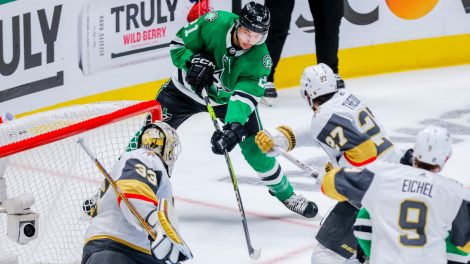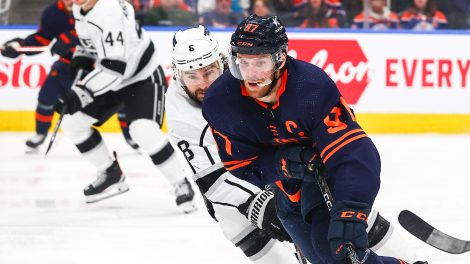Each week, Justin Bourne’s column will cover three different topics in varying depths. Think of it as a three-course meal with an appetizer, main course, and dessert…
Appetizer: The NHL’s zero-to-100 play-in schedule is gonna be a rush
Imagine being told you’re not allowed to have sugar anymore, for some indefinite period. At first you’d miss certain treats. Some food would taste more bland than you’d prefer, but you’d get used to it. In time it would become normal, even if you preferred it didn’t.
To some extent that’s been all of us with hockey. The deprivation hasn’t been straight-up “You can’t have food at all” bad — just more like something we regularly enjoyed was taken away. We noticed it a lot initially, and we wondered what we could even consume in its absence. But we eventually settled on halfway-decent substitutes and found a way to move on.
Now consider August of 2020, when all of us are now going to be asked to snort Fun-Dips through Pixie Stix from noon ’til night, day upon day. The NHL is serving cookie dough for lunch.
Have you seen the planned schedule for the NHL’s return to play? We’ve been dying for even just a single sweet taste of hockey — now we’re about to be shoved in the chocolate river at Willy Wonka’s Factory like Augustus Gloop.
There will be games starting at 12:00, 4:00, and 8:00 p.m. in Toronto. There will be games starting at 12:00, 4:00, and 8:00 p.m. in Edmonton. Which means that if you’re on the east coast, games — essentially playoff games, mind you — will begin at 12:00, 2:00, 4:00, 6:00, 8:00, and 10:00 p.m. (shift that whole timeline three hours earlier out west, which is even better).
We’re looking at a month of six games a day, all day, everyday. God forbid there’s any number of significant overtimes, or we could be talking about midnight (or later) puck drops some days, which will almost definitely happen because as Brian Burke explained, “It’s 2020 — of course it will.”
Here, maybe wash all that sugar down with some Kool-Aid, as served by the NHL:

I don’t think my family is prepared for this. I don’t think I’m prepared for this. It may not be healthy, but I’m still gonna try to take in as much as I can.
Main course: Can we learn anything about the teams involved from these initial five-game series?
Heading into the play-in round of NHL action, I feel like I could argue either side of the debate “Will we actually learn anything from these games?” Specifically, I’m wondering whether we’ll learn anything about who these teams are, or whether all bad showings will be chalked up to “Well, they haven’t played in four months” or “small sample.”
How much will a team’s play when they first step on the ice reflect on what that team actually is?
As implied above, you can already hear the excuses for those who fail — a few of which would of course be legitimate. How can you judge a team in a sport where one breakdown kills a defensive structure when nobody’s played real hockey in over four months? You’re only as strong as your weakest link, and you know at least one guy per team will have been aversely affected by this weird hiatus.
Combine that with the reality that anything can happen over five games in the NHL, and it can be easy to take the nihilistic view that no result from this August will really matter. Hell, here’s the top of the Atlantic Division standings three weeks into this NHL season:
| W-L-OT | ROW | Pts | |
|---|---|---|---|
| Buffalo | 9-2-1 | 8 | 19 |
| Boston | 6-1-2 | 6 | 14 |
| Toronto | 6-4-2 | 6 | 14 |
| Florida | 4-2-4 | 3 | 12 |
| Tampa Bay | 5-3-1 | 4 | 11 |
| Montreal | 4-4-2 | 3 | 10 |
The Sabres!
All that said, however, there’s fair pushback to be made to the “nothing really matters” case, which primarily comes in two forms. One is that most teams are fully healthy, which is insanely rare at this time of year. And two is that they actually have their lineups crystallized. It’s rare that those two items overlap for one NHL team in a season, let alone all for all of them at once.
The first point is the most important one. Every year entering the playoffs, teams are missing a number of key players who would’ve made real differences, and accounting for their absences can be really hard when assessing legitimate team quality. It’s tough to fairly gauge a goaltender when great defencemen are missing; it’s tough to gauge a skill player when he doesn’t have a regular skill player to play off of. And since teams are built as cohesive machines, injured parts unfairly punish teams at what seems to be random.
Further to that, we’re often unsure which guys are playing hurt. It makes it tough to assess who’s getting slowed by a nagging injury, and who’s just having an off-week. For the first time ever, we’re pretty confident everyone dressed in a playoff-like series feels capable of ably playing hockey, save for maybe needing shorter shifts.
The second thing I mentioned, that lineups are crystallized, speaks to what happens in the early going for teams. There’s a lot of internal tryouts and guessing-and-testing that happens. In months one and two, a right winger is often competing against other right wingers on the team for the best linemates, more minutes, and special-teams time. Coaches experiment with guys to see what they have. There are games where the outcome isn’t all a coaching staff is concerned with. By the second half of the year that mostly stops (except by way of necessity or abject failure to that point), and teams finally roll with what they’ve found works best.
That won’t be the case in the coming weeks. Even though everyone is coming in like they would after a summer off, most players know exactly where they stand, who they’ll be playing with, and what sort of usage to expect. It’s about winning here as a team, not jockeying for internal position. An uncommon addition to all this, is that coaches have time to figure out how to best optimize their lineups. That’s a luxury they don’t have most years.
So I can see how these games might truly show us something of value, where teams are in their proper units, everyone is in the lineup and nagging injuries aren’t yet a thing.
I joked earlier here by clipping the standings three weeks into the NHL season (Oct. 25) to highlight the Sabres start, which doesn’t jibe with the rest of their season. But guess what? If I zoom out to look at the entire Eastern Conference on that same date, look what happens. Start by looking at the bottom of the table.
| W-L-OT | ROW | Pts | |
|---|---|---|---|
| Buffalo | 9-2-1 | 8 | 19 |
| Washington | 8-2-3 | 7 | 19 |
| Boston | 6-1-2 | 6 | 14 |
| NY Islanders | 7-3-0 | 6 | 14 |
| Toronto | 6-4-2 | 6 | 14 |
| Carolina | 6-3-1 | 5 | 13 |
| Columbus | 5-3-2 | 5 | 12 |
| Florida | 4-2-4 | 3 | 12 |
| Pittsburgh | 6-5-0 | 6 | 12 |
| Tampa Bay | 5-3-1 | 4 | 11 |
| Montreal | 4-4-2 | 3 | 10 |
| Philadelphia | 4-3-1 | 4 | 9 |
| NY Rangers | 3-4-1 | 3 | 7 |
| Detroit | 3-8-0 | 3 | 6 |
| New Jersey | 2-5-2 | 2 | 6 |
| Ottawa | 2-7-1 | 2 | 5 |
Three of the four teams that ended up missing the play-in round had already weeded themselves out, and it was just Buffalo who was way out of whack. Washington and Boston were in the top three at that point, just as they were when the season abruptly ended in mid-March. While there will always be some outliers who just get a bad short-term shake, it generally doesn’t take that many games for teams to show who they really are.
Given what I mentioned above – we’ll see fully healthy teams not worried about anything but wins – you can expect those small samples to be even more telling about a team’s true ability.
So when these opening series get under way, there will certainly be randomness, and it’ll be dicey to draw any hard conclusions from the first wave of results. But I’d caution against assuming these series are just coin flips. In some ways, we’re going to get a better look at what these teams really are than we’ve ever seen before.
Dessert: The players aren’t going to have a dress code, and it’s going to be a delight
I don’t really understand why players won’t have a dress code anymore in the hub — not because I think they should, but because basically nobody ever sees the guys in their suits heading to the rink at 3:30 anyway. I don’t see what’s changed. The only time they do get seen is when there’s a camera crew there looking for some b-roll, and I don’t imagine the presence of the cameras at that time of day is going to be any less frequent than it would’ve been during the regular season. Hell, there’s three games a day at a single rink — there’s probably more cause for there to be cameras around before the games.
Regardless, there’s going to be no dress code, which will be an absolute delight. Here in Toronto there’s no shortage of names off the top of my head ready to vie for the title of “NHL Russell Westbrook” (Matthews, Nylander, Marner, Kapanen and Dermott come to mind — maybe Andersen, too). The NBA has brought some wild looks over the years, and while I don’t expect the NHL to quite get to that level, don’t sell some of these young kids short. I bet there’s a lotta shopping going on right now among players who care about style as an extension of personality. Stay tuned.
[relatedlinks]








